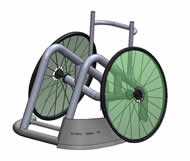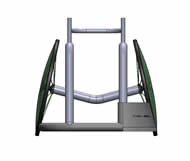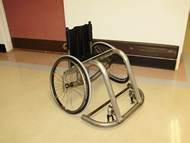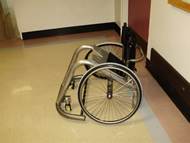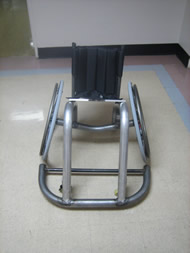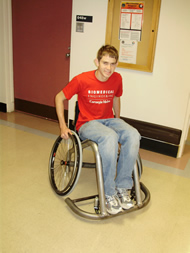Brian Harvey1,2 ; Joseph Gibbs1 ; Ryan Keitzer1; Dan O’Toole1
1 Department of Biomedical Engineering, Carnegie Mellon University, Pittsburgh, PA
2 Human Engineering Research Laboratories, VA Pittsburgh Healthcare System, Pittsburgh, PA
ABSTRACT
Wheelchair rugby is a highly competitive, high contact wheelchair sport. The players need wheelchairs to be as fast, maneuverable, and as light as possible. This paper puts forward a novel rugby wheelchair design that utilizes large diameter thin wall tubes to reduce weight. A client, who is an avid rugby player, was identified and interviewed regarding his expectations for a new rugby chair. A cantilever style design was completed and fabricated. The client evaluated the prototype and provided feedback. The prototype had less parts and welds than a typical rugby wheelchair, but had comparable weight. This concept could lead to lighter, stronger, lower cost chairs, which could increase performance and participation in wheelchair rugby.
KEYWORDS
Rugby, Wheelchair, Activity, Sports Performance
BACKGROUND
It is widely recognized being physically active is beneficial for one’s well being. O’Neil et al. discusses the range of benefits participation in sports has for someone with a spinal cord injury and states “the rehabilitation team has an important opportunity to maximize health and potential to increase quality of life by introducing sport in rehabilitation” (1). Today, a large number of sports have been adapted to provide athletic activities for wheelchair users. One such sport for people with tetraplegia is wheelchair rugby. It is an excruciating, very high contact sport with heavy demands on chair performance.
Several wheelchairs on the market target wheelchair rugby players. However, little scientific literature exists in the area of rugby wheelchair design. Vanlandewijck et al. state that, “the movement dynamics in wheelchair basketball and rugby are specifically related to handling the wheelchair and can be defined as starting, sprinting, braking, turning (pivoting) and blocking” (2). The paper goes further to claim “the ability to accelerate quickly from standstill is far more important than sprinting” (2). Grindle et al. reported that recreation rugby players stopped and started approximately eight times per minute and traveled 2364.7m per game (3). Scientific advisors to the U.S. Paralympics Team have identified new designs for rugby wheelchairs as a priority, based on observation at the 2008 games in Beijing, China.
The design team worked closely with an avid competitor to personalize a new style of chair. The client has provided design criteria, experience, and his personal aluminum chair to make comparisons. The client is an offensive player, which requires greater maneuverability, speed, and agility. Therefore, this design incorporated these factors.
RESEARCH QUESTION
The purpose of this chair is to demonstrate the benefits of constructing a wheelchair from large diameter, thin walled tubing. With this design, lighter chairs are producible at lower costs while maintaining comparable performance and safety to other current models. The goal was to create a proof of concept for such model. While this chair is not optimized for game play, it can be used as a reference to further feedback from users. A better second generation chair is high anticipated which incorporates participatory action design processes.
METHODOLOGY
Client Participation
An initial interview was conducted with the client to ascertain the features he would desire in new wheelchair design. At this time an evaluation of how the client used his current chair was performed, along with collecting key physical measurements of the client. The client was consulted at various times during the development as to his preference on design features and was again interviewed after he evaluated the completed prototype.
Design
The design was centered around large diameter, thin walled tubing. This is advantageous because strength is proportional to the diameter of a circle to the fourth power and weight depends upon diameter to the second power. The increase in strength of the tubing reduced the need for numerous supports and gussets typically found on rugby chairs. The overall geometry was determined using the client’s physical dimensions and IWRF regulations for chairs. Other design constraints included the bending limitations of large diameter tubing and the desire to keep the center of mass close to the center of the drive wheel, which enhances maneuverability and tip over stability. SolidWorks CAD software was used to create 3-D models of the design. A cantilever style design was chosen and an effort was made to minimize parts and welds through geometry. Three views of the final solid model are given in figure 1, 2, and 3. Steel was selected as the material since it can be bent in tight radii with large tube diameters and has the ability to be readily welded. Specifically, two inch outside diameter, 0.065 inch thick wall steel tubing fit the desired strength and durability.
Fabrication
Fabrication of the wheelchair was carried out in an academic advanced prototyping and machining laboratory. Steel tubing was bent with a hydraulic pipe bender. Steel and aluminum parts were machined using a combination of manual and computer numeric controlled mills and lathes. Several custom jigs were created to facilitate welding, which was carried out with a MIG welder. Additional plastic parts were created using selective laser sintering (SLS).
RESULTS
The final manufactured wheelchair weighed 39 lbs (17.7 kg) and is comparable to the client’s current aluminum chair. The chair is composed of approximately thirty components. Twelve are off the shelf items. This is fewer parts than currently available wheelchairs. Figure 4, 5, and 6 below are isometric, side, and front views of the finished manufactured wheelchair, respectively
These figures demonstrate the product is consistent with the computer model design. The chair meets the specifications and dimensions provided by our client and IWRF. The wheelchair was tested by the client and his overall impression was very positive. In particular, his first impression was the chair will be rigid and commented on the sleek design and similarities to high end chairs. Figure 7 is a photograph of the primary author testing out the finished wheelchair.
DISCUSSION
The research objective was to develop a proof of concept prototype for a new, cantilevered offensive rugby wheelchair which may allow for lighter and lower cost rugby wheelchairs. A cantilever style wheelchair allows for fewer parts and eliminates unnecessary supports and gussets which results in a lower cost, lighter, and easier to manufacture wheelchair. The wheelchair is only slightly lighter than current chairs, but could be optimized for different materials. Casual or beginner players might perhaps prefer a lower cost, steel chair while higher level players might benefit from an aluminum chair. Our lighter wheelchair may allow for higher top speeds and acceleration and increased maneuverability. Furthermore, it will allow players to compete at a higher level for longer periods of time and reduce the risk of injury (4). Additionally, lower cost rugby wheelchairs may increase participation in the sport, especially since sports wheelchairs are typically funded by the consumer, not insurance providers. Further feedback from users through participatory action design is required for a complete evaluation of this first generation design. Based on this feedback, an improved design could be implemented to make the chair even more user friendly. Another important future step for this generation is to carry out durability testing and field trials. Since this is a proof of concept a few limitations should be noted, including: limited budget, manufacturing limitations, and it focuses on one specific client. Future iterations of this wheelchair design could optimize the tube diameter to reduce weight while maintaining sufficient strength. Also, the design could be optimized for manufacturing and to accommodate the size needs of a wider range of players.
REFERENCES
- O’Neill, SB., & Maguire S., (2004) Patient perception of the impact of sporting activity on rehabilitation in a spinal cord injuries unit. Spinal Cord, 42, 627-630.
- Vanlandewijck, Y., Theisen, D., & Daly, D., (2001) Wheelchair Propulsion Biomechanics. Sports Medicine, 31, 339-367.
- Grindle, G., Sporner, M., Cooper, R., Kelleher, A., Teodorski, E., & Cooper, R., (2008) Quantification of Activity during Wheelchair Rugby at the National Veterans Wheelchair Games. In Press: Proceedings of the RESNA Conference 2009.
- Boninger, ML., Koontz, AM., Sisto, SA., Dyson-Hudson, TA., Chang, M., Price, R., Cooper, RA., (2005) Pushrim biomechanics and injury prevention in spinal cord injury: recommendations based on CULP-SCI investigations. Journal of Rehabilitation, Research, and Development, 42, 9-19.
ACKNOWLEDGEMENTS
This study was supported by the VA Pittsburgh Healthcare System and the University of Pittsburgh Human Engineering Research Laboratories, under VA RR&D center grant number B3142C and NSF Quality of Life Technology Engineering Research Center, EEC-0540865.
We would also like to thank Dr. Rory Cooper, Dr. James Antaki, Dr. Conrad Zapanta, Mark McCartney, and Garrett Grindle.
AUTHOR CONTACT INFORMATION
Brian Harvey
5522 Raleigh Street
Pittsburgh, PA 15217
(410) 491-9112
brian.c.harvey@gmail.com
